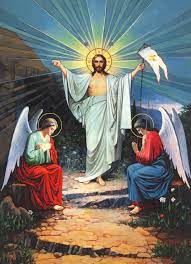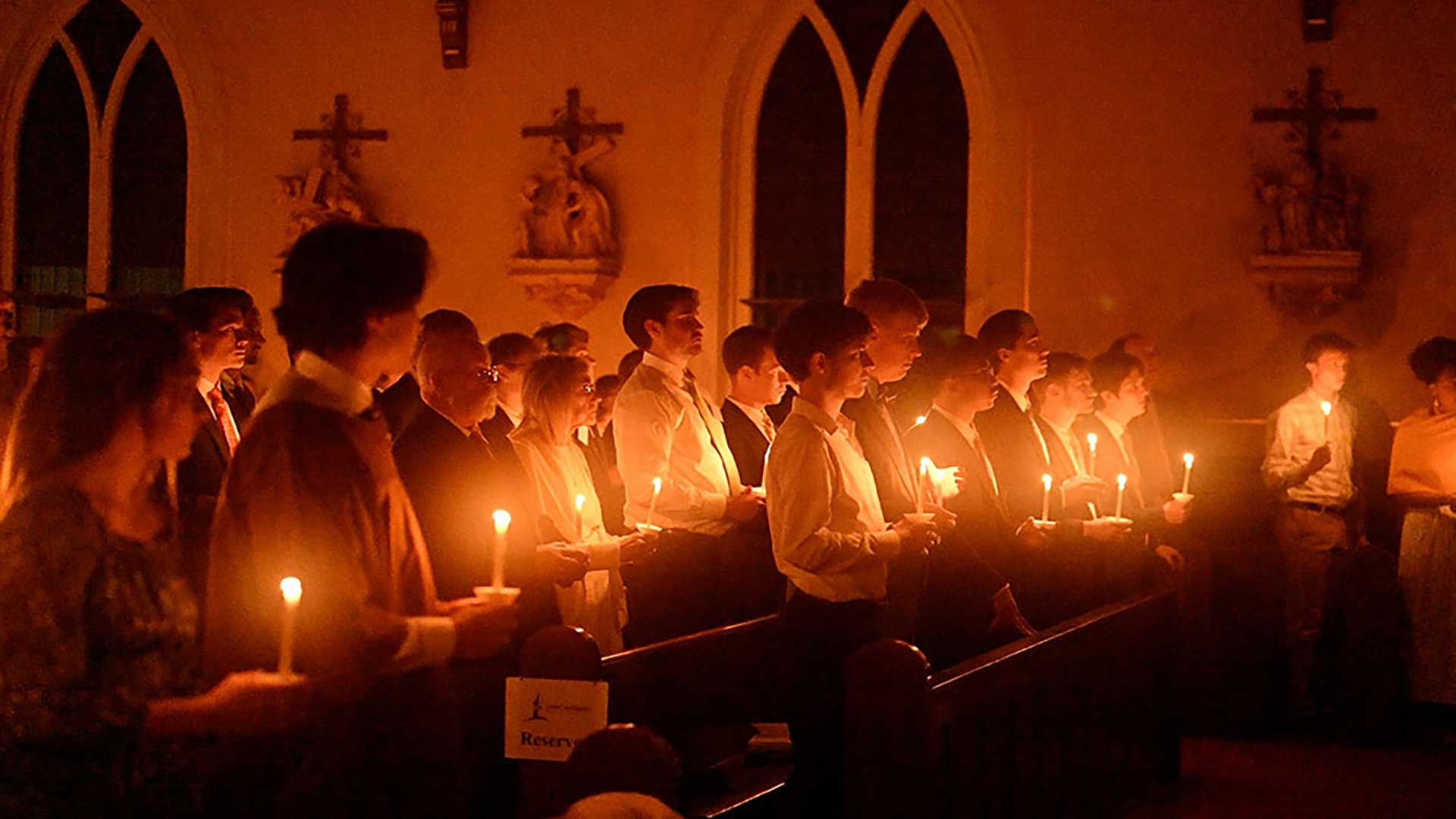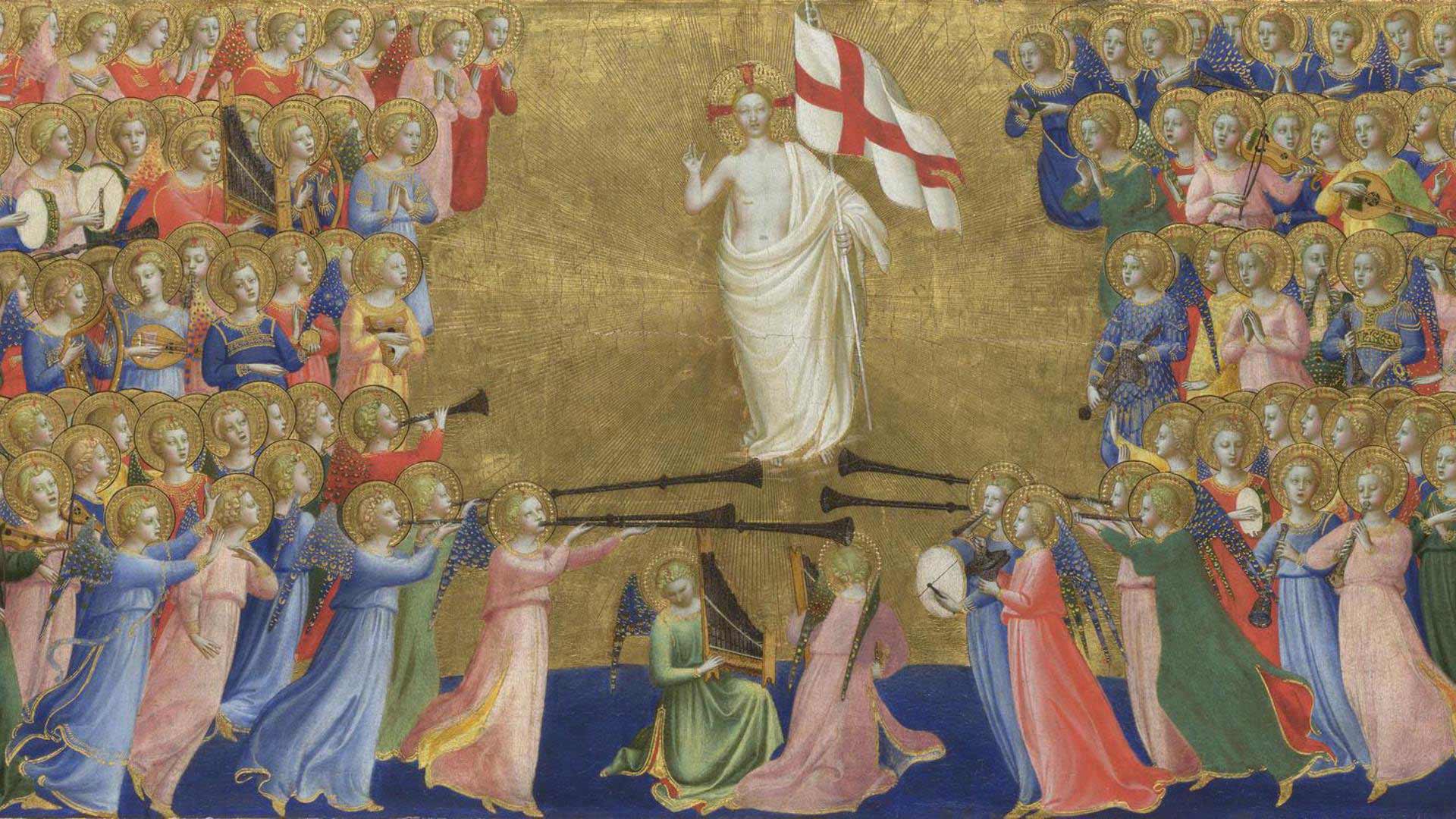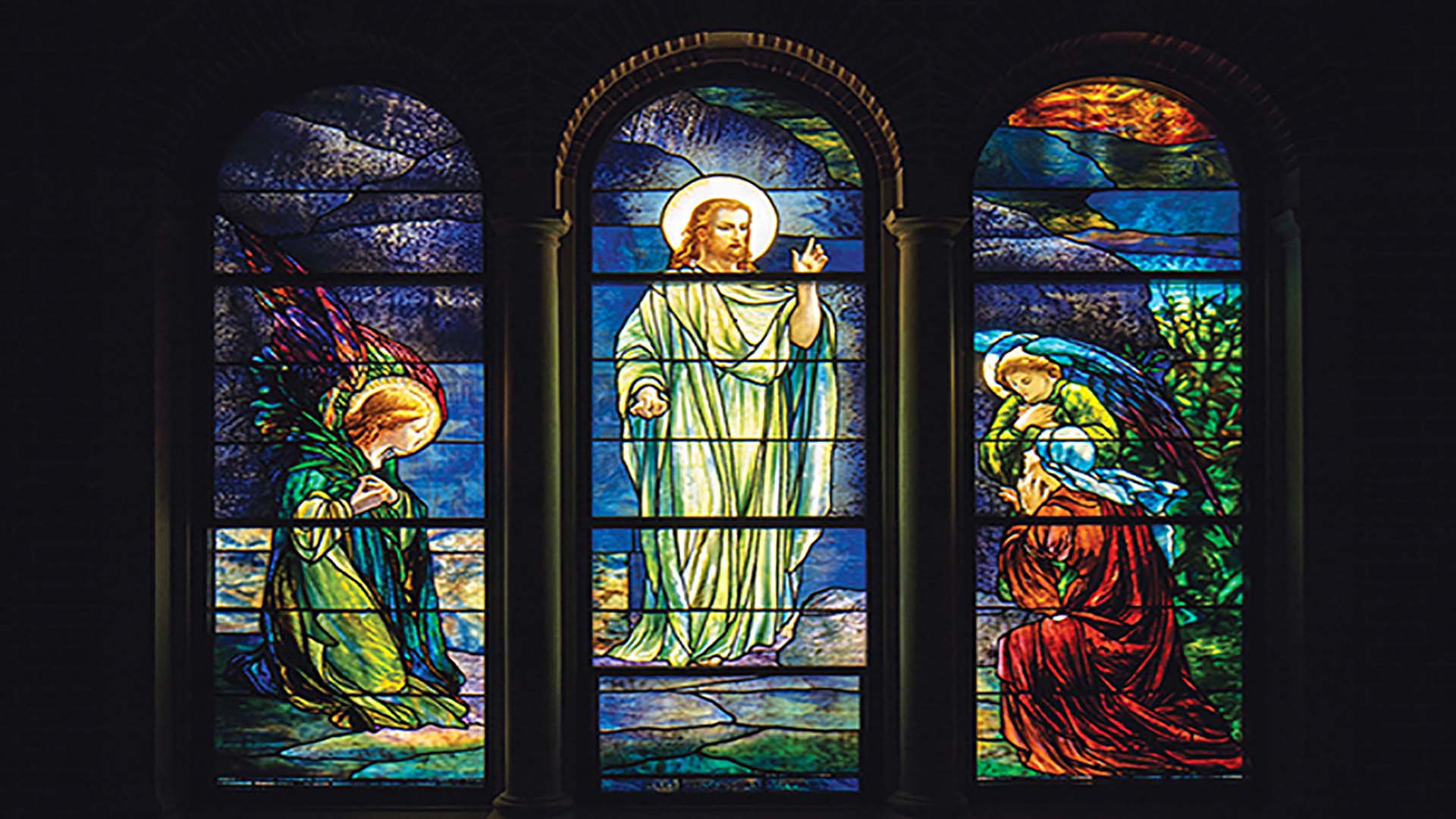The Holy Night of our Lord's Return
The Church today observes solemn vigils[1] for Christmas, Easter, and Pentecost. The Easter Vigil, which begins on the evening of Holy Saturday, has by far the longest, the most ancient, the most sacred, the most profound and most beautiful of all the liturgies of the Catholic Church. St Augustine has called it ‘the mother of all vigils.’
The Easter Vigil is divided into four parts: Service of the Light; Liturgy of the Word; Liturgy of Baptism; Liturgy of the Eucharist, as follows:
SERVICE OF THE LIGHT: This begins outside the church building. Whereas inside, the holy water fonts are drained, the tabernacle is empty and the lights are out; outside a new fire is lit and blessed, as a symbol of life. The priest uses a stylus to cut a cross into a Paschal Candle. Then he makes the Greek letter Alpha above the cross, the letter Omega below, and the four numerals of the current year between the arms of the cross. The Paschal Candle symbolises Christ, the Light of the World, the Beginning and the End, and to Whom all time and ages belong.
The traditional Easter song follows, sung usually by a deacon: the Exultet (Easter Proclamation). ‘This magnificent hymn, which is remarkable for its lyric beauty and profound symbolism, announces the dignity and meaning of the mystery of Easter; it tells of man's sin, of God's mercy, and of the great love of the Redeemer for mankind, admonishing us in turn to thank the Trinity for all the graces that have been lavished upon us.’[2]
LITURGY OF THE WORD: It comprises nine Readings, seven from the Old Testament and two from the New Testament.[3] They help us meditate on God's wonderful works for His people since the beginning of time:
- Story of Creation (Gen 1: 1-2; 2)
- Abraham put to the Test (Isaac) (Gen 22: 1-18)
- Moses and the People crossing of the Red Sea (Exodus 14: 15–15; 1)
- The New Zion (Isaiah 54: 5-14)
- God’s Invitation to His People (Isaiah 55: 1-11)
- In Praise of True Wisdom (Baruch 3: 9-15.32–1:4)
- Renewal of Israel (Ezekiel 36: 16-28)
- Dying and Living with Christ (Epistle, Romans 6:3-11)
- The Resurrection (Gospel, Year A: Mt 28:1-10; Year B: Mk 16:1-7; Year C: Lk 24:1-12)
The Gloria is sung before the Epistle, and the Alleluia before the Gospel.
LITURGY OF BAPTISM: Water is blessed, signifying new life; new members are brought into the Church through baptism and those who were baptized but have not received the other sacraments of initiation. The catechumens and these faithful are confirmed and later receive the Holy Eucharist. Then, the faithful are blessed with water and all renew their baptismal promises, reliving the Resurrection and understanding their identity as a People of God. Part of the liturgy includes the Litany of the Saints.
LITURGY OF THE EUCHARIST: The Mass continues, with special prayers inserted during the Eucharist Prayer, and concludes with a solemn blessing: to defend us from every assault of sin; that we may be endowed with the prize of immortality; that we may celebrate the gladness of the Paschal Feast and come with Christ's help, and exulting in spirit, to those feasts that are celebrated in eternal joy. The Mass closes with the glorious singing of the dismissal: ‘Go forth, the Mass is ended, alleluia, alleluia’ or ‘Go in peace, alleluia, alleluia’.
Clearly, the Easter Vigil liturgy is of exceeding beauty and unending splendour. It is a blessing to be a part of this most sacred night when, together with the sons and daughters of the Church scattered throughout the world, we await our Divine Master’s return in glory. We stay up with our lamps full and burning, hopeful that our Resurrected Lord will give us a seat at His table, that is to say, a share in His triumph over death and life eternal.
-o-o-o-
[1] ‘Vigil’ refers to a day or eve before a prominent feast or solemnity. It is observed with special offices and prayers (and, formerly, a fast as well) as a preparation for the following day, honouring a Mystery or a saint to be venerated on the feast day.
[2] With Christ Through the Year, by Bernard Strasser (Quoted by https://rb.gy/wuibl6 )
[3] ‘The number of these readings can be reduced if some particular reasons and circumstances require so. There should be at least three readings from the Old Testament and in some very particular circumstances these may still be reduced to two, before the Epistle and Gospel. But the third reading from Exodus should never be omitted.’ (Lectionary, Catholic Press, Ranchi, 2011, p. 161)
Why Easter is the bedrock of our faith!
It's thanks to Easter that we are Christians. Whereas the joyful birth of Jesus contained a promise, this was fulfilled through His sorrowful Death and glorious Resurrection. This unparalleled event was the ultimate answer to those who had rejected His luminous earthly passage abounding in wise teachings and unprecedented miracles. He who had come to complete the Jewish religion thus founded a new and sublime religion – Christianity – that would be open to the peoples of the world.
The panoply of readings of the Easter Vigil and Mass tells us the story of the redemption of the world. The seven readings[1] from the Old Testament and two from the New Testament are “chosen and structured to lead the worshipping assembly into a deep contemplation of the mystery of salvation history—from the beginning of time, when God created the world in all its wonder, to this moment of the Church gathered in prayer, to the end of time when all things will be brought to perfection once again in God's love.”[2] In other words, the readings tell of the Redeemer about whom the prophets had long foretold.
The Easter Sunday (morning and evening) Mass offers a different set of Readings, of which the Second Reading and the Gospel have internal choices.[3]
Starting with the Gospel: obviously, it is about the Resurrection! If we read the four Evangelists, we cannot fail to see the multiple differences in their accounts. However, the disparity lies only in the secondary details: while St John (in all probability) wrote a first-hand account, the rest of the Evangelists wrote theirs based on eyewitnesses. Most importantly, none are at variance on the fundamental issue: that the tomb was found without the Lord early on Sunday morning. It was not a desecration; it was undoubtedly the Resurrection!
In fact, those variations only go to show that the Resurrection accounts were not tailored; they were written at different times, between circa AD 66 and 110, in this order: Mark (AD 66-70), Matthew and Luke (AD 85-90), and John (AD 90-110). And even if they had never been written, there would still have been other evidence of the stunning event. St Luke’s Acts of the Apostles was put together between AD 70-90, and Paul’s letters between AD 50-58. Clearly, these latter are the earliest extant texts about the Resurrection, predating the first of the Gospels by over a decade. Would God the Father have allowed the most important event of all of history to go unrecorded?
Very pertinently, the first two Readings are taken from the accounts of those two travelling companions, Luke and Paul, respectively. The text of the Acts (10: 34a, 37-43) refers to the by-now fiery St Peter chastising those who put Jesus to death. “But God raised Him on the third day,” he states, “and made Him manifest, not to all the people but to us, who were chosen by God and witnesses, who ate and drank with Him after He rose from the dead.” Faithful to the Divine Master’s command, the future First Pope testifies: “To Him all the prophets bear witness that every one who believes in Him receives forgiveness of sins through His Name.”
Even more clinching is St Paul’s testimony relating to the Resurrection. Here is one of Christ’s worst persecutors, whose conversion history is so well known that it can be dispensed with here. In today’s Second Reading (Col 3: 1-4), he most convincedly points to Christ “seated at the right hand of God”, and invites us to set our minds on things that are on high. It is the same Paul who famously said, “If Christ has not been raised, your faith is futile and you are still in your sins.” (Cor 15: 17) He championed Christ’s cause – His physical Resurrection – which prompted Roman emperor Nero to order his beheading.
Let alone dying like Paul, had we only believed more firmly in the Resurrection and spoken more ardently about this turning point in the history of humankind, by now there would have been only Christian apologists walking the earth and no apologetic Christians in sight! After two thousand years of Christianity, can we say we have done enough?
Let us therefore resolve to rise above our frailties – to rise with Christ and live with Him forevermore, with Him who is indeed the Resurrection and the Life!
[1] The Vigil readings for all Year cycles are as follows: Gen 1: 1-2, 2; Gen 22: 1-18; Ex 14: 15-15, 1; Is 54: 5-14; Is 55: 1-11; Bar 3: 9-15, 32 – 1, 4; Ezek 36: 16-28; and at the Mass thereafter: Rom 6: 3-11 [Year A]; Mk 16: 1-7 [Year B], Lk 24: 1-12 [Year C]
[2] http://pastoralliturgy.org/resources/1301OurStoryOfSalvation.php#:~:text=The%20nine%20readings%20of%20the,to%20this%20moment%20of%20the
[3] The Second Reading can be either from Colossians (3: 1-4) or Corinthians (5: 6-8). And while the first choice of Gospel text is from St John (20: 1-9), one may alternatively take any one of the Gospel texts of the Easter Vigil Mass: Mt 28: 1-10 marked for Year A; Mk 16: 1-7, for Year B; or Lk 24: 1-12, for Year C. The Lectionary also specifies that at evening Mass, Gospel of the Third Sunday of Easter, Year A, may be read.
Banner: https://www.nationalgallery.org.uk/paintings/fra-angelico-christ-glorified-in-the-court-of-heaven
Easter, a joy for ever
After a slew of emotions that we experienced through the forty days of Lent, finally that time of the year has arrived when we have much to rejoice over! The Lord is risen: it’s Easter! Alleluia!
How did the Resurrection come to be called ‘Easter’? The ninth-century monk Venerable Bede says the name derives from Eostre, the spring month named after the pagan goddess of fertility. Others say the root of ‘Easter’ goes back to Old English, with a Germanic root related to the cardinal direction East, and yet others point to the Latin aurora, dawn. So, ‘Easter’ is only a colloquial substitute for ‘Pasch’! Be that as it may, Lent is indeed be a springtime for the soul and, if Christ be the Sun, Easter is easily a new dawn for the Christian world.
But, hugely more important than etymology is Christ We know that Christ was on a visit to the City of David, to celebrate the Jewish Passover, when He was summarily arrested and crucified. Looking back, there was no longer any use for the animal sacrifice: Christ Himself had become the Paschal Lamb. Then, with His glorious Resurrection on the third day, He introduced humankind to a New Passover, which we call Pasch or Easter.
We know that Christ was on a visit to the City of David, to celebrate the Jewish Passover, when He was summarily arrested and crucified. Looking back, there was no longer any use for the animal sacrifice: Christ Himself had become the Paschal Lamb. Then, with His glorious Resurrection on the third day, He introduced humankind to a New Passover, which we call Pasch or Easter.
Whether the ‘third day’ was meant to be a period of seventy-two hours or less is of no consequence! At any rate, the Resurrection was an unprecedented happening. The earth-shaking event established Christ’s divinity and validated all His claims and promises. Humankind had indeed met face to face with the True God. No wonder it led to the establishment of a new religion – Christianity.
Whereas our ancestors in faith met God in person and witnessed the Resurrection, many may wish to know the practical significance of the happening to our day and age. Indeed, to us, Easter is a complete gamechanger; its joy transforms us and the way we look at life. And who can fail to appreciate Christ’s message of love and compassion? Has it not made the world a better place to live in? And although physical suffering proper to the human condition lingers on, humankind has been freed from the oppression of sin.
Finally, Christ’s Resurrection is a guarantee of our eternal salvation and that we will be raised from the dead at His Second Coming. St Paul says, ‘If there is no resurrection of the dead, then Christ has not been raised. And if Christ has not been raised, our preaching is empty and our belief comes to nothing.’ (1 Cor 13-15) Hence, Resurrection is the cornerstone of our faith. Its commemoration is no hollow ritual but a meaningful commemoration; it is not just another day but a watershed in the history of salvation.
We say we are an Easter people and Alleluia is our song! This line attributed to St Augustine and popularised by St Pope John Paul is an apt description of our Christian identity. We are to be recognised not by the dress we wear or the food we eat, but by the way we conduct ourselves – with joy; by the way we treat one another – with love; and by the way we relate to our God – body and soul, with hope, praise and thanksgiving.
Easter brings us hope. With its splendour before our eyes, no matter what the circumstances, Easter is a joy for ever.
He has risen, Alleluia!
EASTER SUNDAY 2020
Readings: Acts 10: 34a, 37-43; Ps 117: 1-2, 16-17, 22-23; Col 3: 1-4; Jn 20: 1-9
After a quarantine marked by a grim Liturgy of the Word followed up by a Triduum of hope, the day has finally come when our Light, Life and Hope has broken all barriers and made Himself manifest. What joy for those who observed the Lenten period in prayer, fasting and almsgiving!
Nine readings are prescribed for the Easter Sunday Vigil Mass, seven from the Old Testament and two from the New Testament. But let’s restrict ourselves to the three readings prescribed for the Easter Sunday morning Mass.
Today begins a new cycle of readings, all of them from the New Testament writers. Particularly the first reading – from the Acts of the Apostles – will go on uninterruptedly up to Pentecost Sunday (with the exception of the Vigil Mass). This fifth book of the New Testament, written in all probability by the Evangelist Luke, provides a valuable history of the early Christian church.
Today, we see Peter joyfully announcing that Christ has risen. A man who lived with Jesus vouches that He is not just a man: anointed by God’s Spirit, He has the fullness of God in Him. He is undoubtedly the Messiah, who showed His true nature by way of miracles, of which the Resurrection is the most definitive. He is the Life who has conquered death. He has commanded Peter and the other apostles “to testify that He is the one ordained by God to be the judge of the living and the dead.” He is the Saviour whom all of humankind is invited to follow and accept, and “everyone who believes in Him receives forgiveness of sins through His name.”
Peter, who had once lost it and denied his Master, now speaks with the courage of his convictions. He is already showing up as the leader of the nascent Apostolic College. And so was it with Paul. He had persecuted Christ but now, filled with the Holy Spirit, he urges others to follow Christ. Pointing at the One “who is seated at the right hand of God”, he vouches that “when Christ who is our life appears, then you also will appear with him in glory.” We too, by our baptism, have died to sin and risen with Christ to a new life. Hence, in the world in which we live, whatever our station in life, we are duty-bound to work towards our collective happiness on earth but never forgetting that Heaven is our final destination.
Indeed Christ’s Resurrection is His glory. What a slap it was to those who didn’t believe and put to Him to death. Against facts there are no arguments! At first, only a few remembered Him, had faith and persevered. One of them was Mary Magdalene. She came to the tomb and, wonder of wonders, the stone had been rolled away! Did she understand what had happened? Was she scared? She suspected sabotage, as we can conclude from what she told Simon Peter and John. When these two reached the tomb, they saw and believed. Mind you, till that moment “they did not know the scripture”, that is to say, they’d never understood what Jesus had told them in his three-year ministry. Only just now it dawned on them that He had really risen from the dead!
Don’t we too go through many Lents and Easters of our life as though they are mere rituals? Let’s hope that our faith has progressed such that this year it has dawned on us that Christ really rose two thousand years ago after an excruciating Passion and Death. Let’s believe and testify that He does so every day at the Holy Sacrifice of the Mass. This is what is meant by the "Real Presence" of Christ in the Eucharist. The Risen Christ is present to his Church in many ways but most especially sacramentally, through His Body and Blood.



